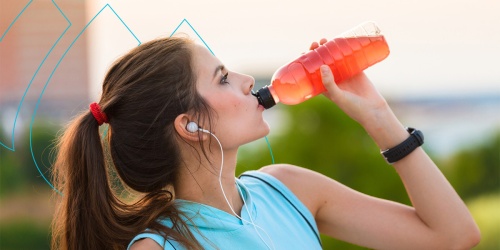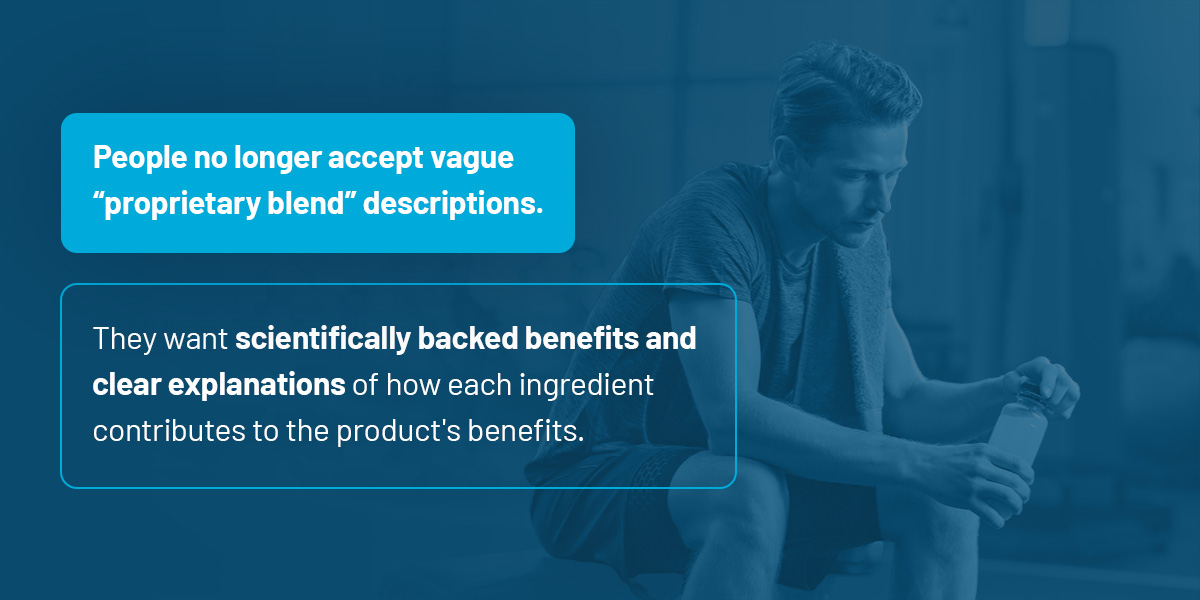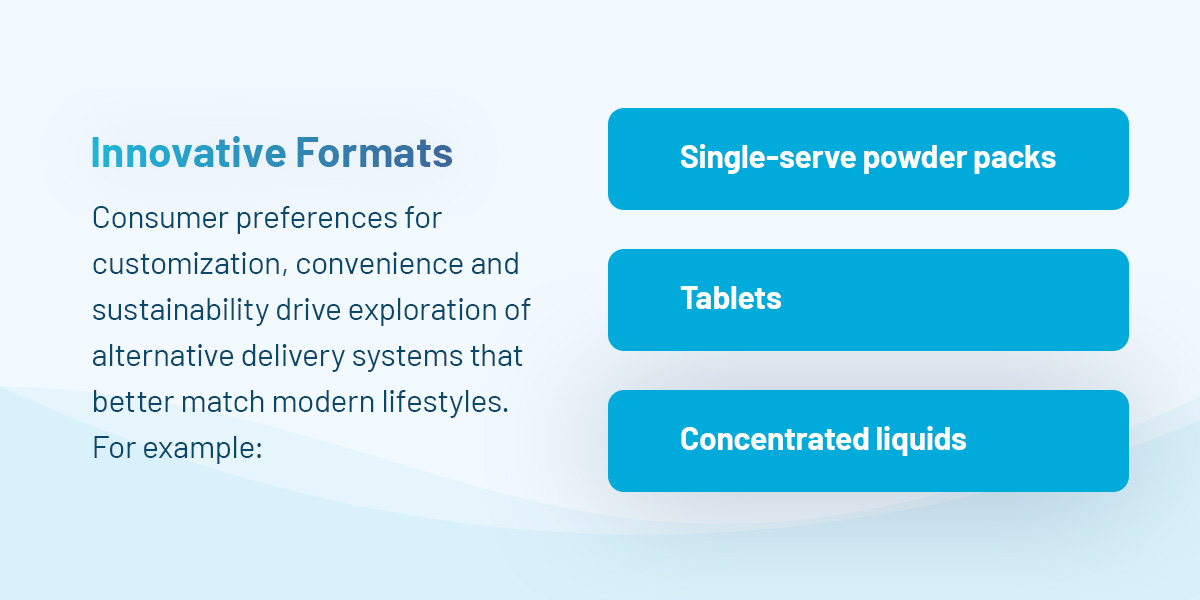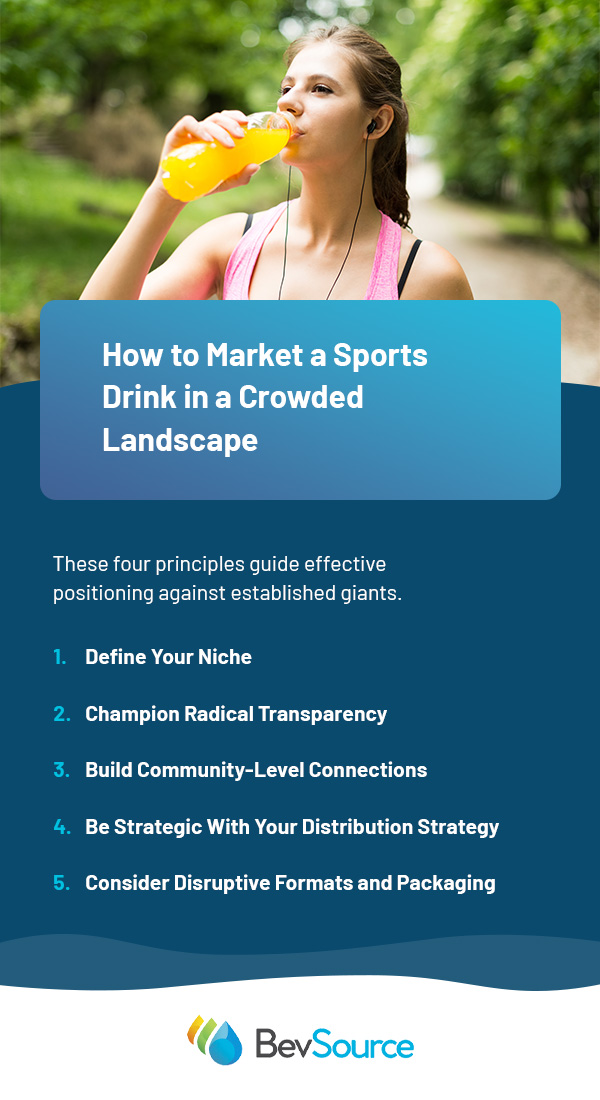7 Trends in Sports Drinks

The sports drink category has undergone a remarkable transformation in recent years. Once confined to locker rooms and marathon finish lines, these beverages now occupy prime real estate in office refrigerators, gaming setups and yoga studios. This evolution reflects a fundamental shift in consumer preferences — many are looking for beverages that support personal wellness goals.
Today's sports beverages barely resemble the simple electrolyte solutions of decades past. In addition to rapid rehydration, consumers are looking for products that offer cognitive support, immune benefits and stress relief. As proactive wellness becomes the norm, trends in sports drinks point toward a future where new sports drinks are formulated to address increasingly specialized needs.
How Consumer Demand Is Reshaping the Sports Drink Market
Changes in demand are driving the growth of sports drinks.
1. Consumers Are Practicing Proactive Hydration and Learning More About Hydration Science
Consumers are no longer waiting for thirst to strike. They practice proactive hydration, viewing proper fluid balance as essential to their daily lives. This mindset shift has transformed sports drinks from emergency interventions into everyday wellness tools.
Consumers are also learning more about electrolyte balance and cellular hydration. This knowledge drives demand for products that optimize hydration through scientifically formulated mineral ratios and osmolality levels. Enhanced hydration has become the baseline expectation rather than a premium feature.
2. Consumers Are Reading Labels More Closely
Many consumers scrutinize ingredients and make choices based on comprehensive evaluations rather than trusting marketing claims. Clean-label sports drinks eliminate artificial additives, colors and sweeteners.
Natural alternatives are gaining ground for their perceived health benefits and ability to align with wellness-focused lifestyles. Low- and no-sugar formulations are increasingly favored as consumers seek to reduce their sugar consumption.
3. Consumers Want Functional Ingredients in Formulations
The ingredient revolution extends beyond formulating beverages with natural sweeteners. Consumers are also looking for functional ingredients in sports drinks, beyond the classic electrolyte blend of sodium and potassium. Popular functional ingredients include:
- Branched-chain amino acids (BCAAs).
- Immune-supporting vitamins and minerals.
- Botanical extracts.
- Protein.
- Adaptogenic herbs.
4. Consumers Want Beverages That Fit Their Dietary Needs
Many people follow specific diet plans, and each has specific requirements and deal-breakers. Keto adherents want unsweetened options, plant-based athletes need vegan amino acid sources, and paleo enthusiasts want sports drinks with simple ingredients. These communities are driving innovation across the category by demanding solutions that align with their dietary philosophies.
5. Consumers Are Finding New Occasions to Enjoy Sports Drinks
The occasions for sports drink consumption have multiplied exponentially. More people are kickstarting their mornings, combating afternoon slumps or preparing for workouts with sports drinks variations. This all-day approach to hydration represents one of the most important sports drinks trends reshaping the category.
7 Sports Drink Trends Shaping the Beverage Market
The sports drink category continues to evolve rapidly, driven by consumer demands for healthy, functional and sustainable options. These seven trends define the current market dynamics and point toward future opportunities.
1. Shift to Clean-Label Options

The movement toward zero-sugar sports drinks is more than a passing fad. It reflects fundamental changes in how consumers evaluate beverages. Sugar content has become a primary consideration, with many shoppers automatically dismissing products that exceed their personal thresholds. This shift has forced formulators to achieve palatability through natural sweeteners like stevia, erythritol and monk fruit, which deliver taste without glycemic impact.
Clean-label demands extend beyond sweetener selection. Consumers expect short, pronounceable ingredient lists featuring recognizable components. Artificial colors face particular scrutiny, with vegetable-based alternatives becoming more popular. Preservative systems rely increasingly on natural acids and plant extracts rather than synthetic compounds.
The botanical revolution also brings exciting possibilities to sports drink formulation.
- Turmeric has anti-inflammatory properties that may support muscle recovery.
- Ginseng may enhance endurance and reduce fatigue through its adaptogenic properties.
- L-carnitine, while not a botanical, complements plant-based performance ingredients by supporting energy metabolism by facilitating fatty acid oxidation.
These ingredients in sports drinks transform basic hydration into more all-encompassing wellness support.
Consumer education has been crucial in accelerating this trend. People no longer accept vague "proprietary blend" descriptions. They want scientifically backed benefits and clear explanations of how each ingredient contributes to the product's benefits. Transparency is also extending beyond the Nutrition Facts Panel to include sourcing information, production methods and third-party certifications. Brands that provide this transparency build trust and loyalty among skeptical consumers.
2. Expanded Functionality Beyond Hydration
Advanced hydration science is influencing product development. Formulators optimize sodium-to-glucose ratios based on Oral Rehydration Therapy (ORT) principles, maximizing cellular fluid uptake. These technical improvements deliver noticeable performance differences that justify premium pricing.
However, while rapid rehydration remains crucial, it no longer suffices as the sole benefit of sports drink formulations. Consumers expect their beverages to multitask as effectively as they do. This expectation has driven brands to layer multiple functional ingredients to create more appealing benefits.
Cognitive support is a compelling expansion area, with functional ingredients in sports drinks targeting specific outcomes:
- Nootropics, such as L-theanine and alpha-GPC, can enhance cognitive function.
- Adaptogens, including rhodiola, can aid in stress management.
- B-vitamin complexes help support brain function and energy metabolism.
- BCAAs may reduce physical and mental fatigue during exercise and aid in muscle recovery.
Immune function has also gained prominence, accelerated by global health concerns. Vitamin C, zinc and elderberry appear frequently, often with lesser-known supporters like quercetin and beta-glucans. These additions position sports drinks as daily wellness tools rather than occasional performance aids.
Brands can combine these ingredients to tailor their beverages to specific needs. For example, focus formulas combine hydration with brain-boosting ingredients, while immunity blends add antioxidants and vitamins. Stress-relief options incorporate calming botanicals, and recovery-focused formulations address the critical post-exercise window when muscles rebuild and adapt. Branched-chain amino acids provide building blocks for protein synthesis, while tart cherry extract reduces inflammation markers, and magnesium supports muscle relaxation and nervous system recovery. By addressing recovery comprehensively, these products help athletes train more consistently.
While targeting distinct consumer needs, each formulation still maintains core hydration benefits.
3. Broadened Consumer Base and Usage Occasions
Democratization is reshaping the sports drink category, as consumption extends far beyond elite athletes. Instead, everyday people seeking better energy, focus and wellness drive volume growth. For example:
- Office professionals: Office workers are a massive market. They face mental marathons requiring sustained concentration, stress management and energy maintenance. Hydration-enhancing formulas with nootropics and adaptogens resonate strongly with this audience.
- Parents: Parents juggling work, childcare and household responsibilities also need accessible energy and stress support. They gravitate toward cleaner formulations that they feel comfortable consuming regularly. Convenience matters to this time-pressed demographic, making single-serve formats and powder sticks particularly appealing.
- Esports players: The esports phenomenon leads to new consumption occasions. Competitive gamers require sustained focus, rapid reflexes and mental endurance during extended sessions. Specialized formulations combining hydration with cognitive enhancers and sustained energy release, even eye health ingredients, address their unique needs. This niche demonstrates how targeted innovation can create new market segments.
As mentioned, dietary communities are also fragmenting into specific subsegments. For example, carnivore dieters may seek keto-friendly formulations, while people with irritable bowel syndrome (IBS) may search for low-FODMAP beverages.
This fragmentation represents an opportunity for brands, as long as they're willing to understand and address specific consumer requirements.
4. Innovative Formats

Sports drinks are no longer limited to liquids in bottles and cans. Consumer preferences for customization, convenience and sustainability drive exploration of alternative delivery systems that better match modern lifestyles. For example:
- Single-serve powder packs: Powder formats are experiencing explosive growth due to customizable concentration, portion control and extended shelf stability.
- Tablets: Effervescent tablets fizz into action and are extremely convenient. It's easier for the body to absorb the vitamins and minerals in these dissolved drinks than those in conventional liquids or powders.
- Concentrated liquids: Concentrated liquids offer precise dosing for serious athletes who measure every input carefully.
5. Flavor Innovation
Flavor innovation has become a critical differentiator in a crowded marketplace. Classic fruit flavors no longer capture attention — instead, consumers seek unexpected combinations that deliver complexity and sophistication. These are some examples:
- Global flavors: The rise in global flavor influences reflects increasing cultural diversity and culinary adventurousness. These include Asian-inspired profiles like yuzu, lychee and white tea, Middle Eastern notes like rose, cardamom and pomegranate, and Nordic influences featuring lingonberry, elderflower and birch.
- Botanicals: Botanical and herbal notes add sophistication while reinforcing functional benefits. Popular options include lavender for relaxation, ginger for digestive support and mint for cooling refreshment.
- Nostalgic flavors: As consumers long for the '90s and early 2000s, nostalgic flavors are making a comeback. Candy-inspired flavors, like Sherry slush and creamsicle, and flavors inspired by classic drinks like the Shirley Temple are gaining popularity.
- Savory options: Savory options are an appealing market gap that challenge category conventions while appealing to sugar-averse consumers. For example, some unflavored sports drinks feature a slight briny or salty taste.
You might consider launching new sports drinks as limited editions or seasonal releases to increase excitement. You can then elevate successful flavors to permanent status.
6. Technology and Digital Integration
One of the new trends in sports drinks is technology integration. This trend is still in its early stages, but brands are exploring it with vigor. Smart packaging and connected apps or wearables create new possibilities for personalization and engagement. Interactive packaging might involve the following:
- Near Field Communication (NFC) chips enable instant reordering and authentication.
- QR codes unlock exclusive content and personalized recommendations.
- Thermochromic inks indicate optimal serving temperature.
- Augmented reality experiences gamify hydration education.
Another technological integration is mobile applications that extend brand relationships beyond purchase moments. Hydration tracking through smart bottles and wearable hydration monitors powers personalized recommendations. Integration with popular fitness platforms creates seamless ecosystems where hydration recommendations adapt to workout intensity and environmental conditions.
Other options include time-release capsules within bottles that release additional ingredients during consumption, or built-in mixing mechanisms, which ensure the proper dissolution of powder formats.
7. Focus on Sustainability
Environmental consciousness is profoundly influencing purchasing decisions, particularly among younger consumers who view sustainability as a baseline requirement rather than a nice-to-have feature. This shift forces brands to examine every aspect of their operations through an environmental lens. Factors to consider include:
- Packaging: Packaging receives the most visible scrutiny. Aluminum and plant-based plastics are fantastic options for their recyclability. Concentrated formats minimize packaging-to-product ratios, reducing the chances of pollution.
- Ingredient sourcing: When sourcing natural ingredients, prioritize working with suppliers who aim to minimize their environmental impact. Additionally, following fair trade practices helps make farming more sustainable.
- Water stewardship: Brands are prioritizing water conservation efforts, watershed protection initiatives and partnerships with water-focused nonprofits. Some companies achieve water neutrality by replenishing more than they consume through conservation projects.
How to Market a Sports Drink in a Crowded Landscape

Breaking through today's saturated sports drink market demands precise strategies. Success is awarded to brands that identify underserved niches, build authentic connections and accomplish focused go-to-market plans. These four principles guide effective positioning against established giants.
1. Define Your Niche
Winning brands reject broad targeting in favor of laser focus. Instead of chasing "active consumers," identify specific communities with unique hydration challenges. CrossFit athletes value different benefits than trail runners, and esports competitors need cognitive support, not just electrolytes.
Define your core users' exact needs, then formulate and message accordingly. When you solve real problems for specific people, marketing becomes storytelling rather than selling.
2. Champion Radical Transparency
Modern consumers demand complete ingredient transparency. Brands succeed by sharing detailed sourcing stories, formulation processes and clinical backing for functional claims.
Educate audiences about how each component delivers benefits, explain why you chose specific functional ingredients in sports drinks over alternatives, and prominently share third-party certifications. This openness builds trust that transcends individual transactions. Brands that provide genuine transparency earn permission to charge premium prices while building lasting loyalty.
3. Build Community-Level Connections
Authentic partnerships outperform celebrity endorsements every time. Local running clubs, recreational leagues and neighborhood fitness studios provide direct access to engaged consumers.
You can also partner with microinfluencers who genuinely use your products during their training or sponsor grassroots events where your target audience naturally congregates. These community connections build credibility and generate word-of-mouth momentum that paid advertising cannot replicate.
4. Be Strategic With Your Distribution Strategy
Smart distribution accelerates market penetration while preserving margins. Start with specialty retailers who educate customers and support sampling programs. Independent gyms and nutrition stores lend credibility while enabling direct consumer feedback.
Use direct-to-consumer channels to test new formulations and build customer relationships. Once velocity proves concept viability, expand selectively to larger retailers. This narrow-and-deep approach concentrates resources for maximum impact while building sustainable growth.
5. Consider Disruptive Formats and Packaging
Don't default to the conventional bottle. Explore alternative formats like powders, gels or concentrated liquids that offer portability, convenience or sustainability. The right format can enhance performance, shelf life and user experience. Innovative packaging can capture attention and better serve your target audience's lifestyle, whether they're training, commuting or traveling.
Bring Your Sports Drink Vision to Life With BevSource
The dynamic sports drink market rewards brands that understand evolving consumer demands. Current trends in sports drinks favor authentic innovation, precise positioning and operational excellence.
BevSource accelerates your journey from concept to market leadership. With two decades of beverage expertise, we know how to transform ambitious visions into successful products. Our network of 300+ suppliers ensures competitive sourcing for new sports drinks featuring cutting-edge ingredients. We navigate complex regulations while optimizing formulations for enhanced hydration and market appeal. Our comprehensive services are designed to capitalize on emerging opportunities and ensure beverage success.
If you're ready to develop the next generation of sports nutrition solutions, contact our experts today and transform your vision into reality.

